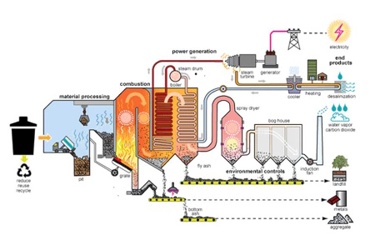Waste-To-Energy Market Insights: Growth, Trends

Waste-to-energy (WtE) is an innovative process that transforms municipal solid waste (MSW) into usable forms of energy, such as electricity, heat, or fuel. As global urbanization intensifies and waste generation increases, Waste to energy technologies offer a sustainable solution for managing waste while simultaneously addressing energy demands. This approach not only reduces the volume of waste sent to landfills but also contributes to renewable energy production, aligning with global efforts to combat climate change and promote sustainable development.
Understanding Waste-to-Energy
At its core, WtE encompasses a variety of processes that convert waste materials into energy. The most common methods include:
- Incineration: Burning waste at high temperatures to produce steam, which drives turbines to generate electricity. Modern incineration plants are equipped with advanced emission control systems to minimize pollutants.
- Anaerobic Digestion: Breaking down organic waste in the absence of oxygen to produce biogas (mainly methane), which can be used for electricity generation or as a fuel.
- Gasification: Heating waste in a controlled environment with limited oxygen to produce syngas, a mixture of hydrogen, carbon monoxide, and methane, which can be used to generate electricity or synthetic fuels.
- Pyrolysis: Decomposing organic materials at high temperatures in the absence of oxygen, resulting in the production of liquid fuels, gases, and char.
Each of these methods has its own advantages and is suitable for different types of waste materials. The choice of technology depends on factors such as the composition of the waste, economic considerations, and environmental regulations.
Environmental and Economic Benefits
- Reducing Landfill Dependence: Traditional waste management practices rely heavily on landfills, which pose several environmental issues, including soil and water contamination, methane emissions, and land usage concerns. WtE significantly reduces the volume of waste that ends up in landfills, mitigating these adverse effects.
- Renewable Energy Production: Waste-to-energy plants contribute to the renewable energy mix by converting non-recyclable waste into electricity and heat. This energy can supplement the grid, reducing reliance on fossil fuels and lowering greenhouse gas emissions. For instance, the energy produced from incinerating one ton of waste can be equivalent to the energy generated from burning one-third of a ton of coal.
- Greenhouse Gas Reduction: By diverting waste from landfills, WtE helps decrease methane emissions, a potent greenhouse gas. Additionally, advanced emission control technologies in modern WtE plants ensure that the release of harmful pollutants, such as dioxins and furans, is minimized.
- Resource Recovery: WtE processes can recover valuable materials, such as metals and minerals, from waste. For example, metals that remain after incineration can be extracted and recycled, contributing to the circular economy.
- Economic Opportunities: The development and operation of WtE facilities create jobs and stimulate economic growth. These facilities require skilled labor for construction, maintenance, and operation, contributing to local economies.
Challenges and Considerations
While WtE offers numerous benefits, it also faces several challenges:
- High Initial Costs: The construction of WtE facilities involves significant capital investment. Financial barriers can be a major deterrent for municipalities and regions with limited budgets.
- Public Perception and Acceptance: WtE plants often face opposition from communities due to concerns about air quality and health risks. Effective communication and demonstration of advanced emission controls are crucial for gaining public support.
- Technological Limitations: Not all types of waste are suitable for all WtE processes. For example, high moisture content in waste can reduce the efficiency of incineration and gasification.
- Regulatory and Policy Frameworks: Stringent environmental regulations are necessary to ensure that WtE plants operate safely and sustainably. Policymakers must balance the promotion of WtE technologies with environmental protection.
Future Outlook
The future of waste-to-energy is promising, with ongoing advancements in technology and increasing recognition of its benefits. Innovations in WtE processes, such as improved gasification techniques and enhanced emission control systems, are making these technologies more efficient and environmentally friendly.
Additionally, integrating WtE with other waste management strategies, such as recycling and composting, can create comprehensive and sustainable waste management systems. Governments and industries are increasingly investing in WtE as part of their renewable energy portfolios and waste management plans.
Source: Transparency Market Research
